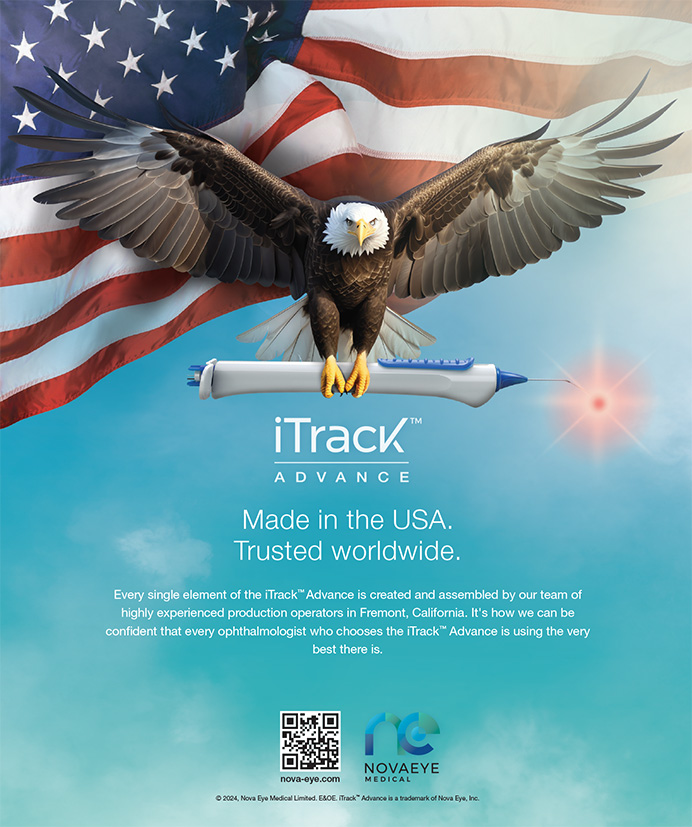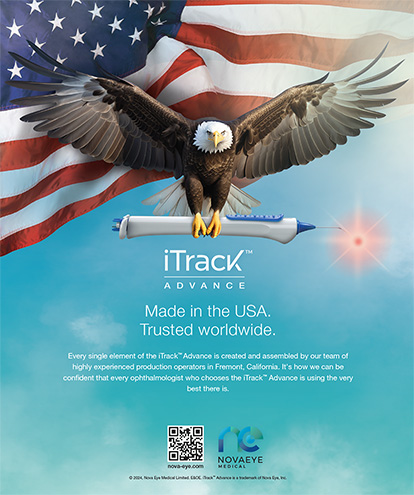Imprimis and Cleveland Eye Clinic Announce Results of Lessdrops Formulation
Imprimis Pharmaceuticals and Cleveland Eye Clinic announced positive results of an investigator-initiated evaluation validating the use of Imprimis' proprietary combination topical formulations for patients post-LASIK surgery, according to a company news release.
The evaluation of Imprimis' proprietary Tri-Moxi (triamcinolone acetonide and moxifloxacin hydrochloride) and Pred-Moxi (prednisolone acetate and moxifloxacin hydrochloride) combination eye drop formulations was led by William F. Wiley, MD, medical director at the Cleveland Eye Clinic and its affiliated laser center, Clear Choice Custom LASIK Center, in order to assess standard follow-up care measurements after LASIK as well as drug quality assurance.
Based on preliminary data, Dr. Wiley said that Imprimis' Tri-Moxi and Pred-Moxi combination eye drop formulations produced equivalent outcomes compared to standard follow-up care measurements observed with traditional post-LASIK eye drop treatments.
“We looked at two different products—Pred-Moxi and Tri-Moxi eye drops—and we wanted to see [whether] it compared to what we were used to seeing with traditional branded formulations,” Dr. Wiley said in an interview with CRST. “What we found was basically, day 1 visions and week 1 visions were very similar to what we see with traditional eye drops. We also wanted to make sure there were no adverse events. We didn't want to see any inflammation, or increased swelling, or any kind of side effects. These are LASIK patients who have a high demand and high expectations, and we wanted to make sure we were matching those, and we found that all the patients were happy. The results of our evaluation look very good. More or less, we saw that we could reduce the amount of drops that the patients were taking. Instead of taking two separate drops, they could take one drop, and the patients did great.”
Based on the results of the preliminary evaluation of LessDrops at the Cleveland Eye Clinic, a formal clinical study is being planned, Dr. Wiley noted.
There were two active treatment arms with a total of 60 patients randomly receiving either one bottle of Pred-Moxi or Tri-Moxi topical drops. Patients were instructed to use their randomized treatment four times a day for 1 to 2 weeks, depending on individual healing times, after their LASIK surgery. IOP, visual acuity, programmed refraction in both eyes, and manifest refraction in both eyes were measured 1 week and 1 month after surgery and compared against preoperation measurements. Visual acuity was also measured at 1 day postsurgery. No additional anti-infective or anti-inflammatory eye drops were prescribed.
There were no safety issues or adverse events, and Imprimis' Tri-Moxi and Pred-Moxi eye drops were well tolerated. At week 1, early in the healing response and during the time the medications were being used, 47% of the patients were seeing 20/15, and 82% were seeing 20/20 or better. These percentages are comparable to what is seen with traditional post-LASIK eye drops, Dr. Wiley said.
Imprimis says the LessDrops formulation will be available in March.
GrayBug Raises $1.74 Million in Series A2 Financing
GrayBug, a privately held pharmaceutical company developing drug-delivery therapies and sustained-release compounds for the treatment of eye diseases, announced the closing of a $1.74-million Series A2 financing round led by new investor Hatteras Venture Partners and existing investor Maryland Venture Fund.
The proceeds will advance the development of GB-102, GrayBug's proprietary microparticle candidate for wet age-related macular degeneration, as well as enable the expansion of the company's development team, according to a news release. Christy Shaffer, PhD, managing director of Hatteras Discovery at Hatteras Venture Partners, has been appointed chair of GrayBug's board of directors.
“This financing from new and existing investors is a testament to the potential of GB-102 and of our proprietary micro- and nanoparticle injectable drug delivery technology,” said Michael O'Rourke, president and CEO of GrayBug, in the news release. “We are especially fortunate to have [Dr. Shaffer] as chair of our board. Her proven business acumen and ophthalmic industry expertise will be invaluable as we advance GB-102 through preclinical development to submission of an [investigational new drug application], and seek to establish strategic industry partnerships that leverage our proprietary sustained-release drug delivery science.”
Spun out of the world-renowned Wilmer Eye Institute at the Johns Hopkins University School of Medicine, GrayBug is developing long-lasting ophthalmic drug products that can reduce the frequency of intravitreal injections needed to treat chronic ocular diseases, including wet age-related macular degeneration and glaucoma. These products are designed based on GrayBug's proprietary sustained-release technology that reduces the inflammation frequently associated with intravitreally administered conventional polymer particles. In addition, the company continues to expand its polymer-based drug-delivery technology portfolio for ophthalmic applications.
“I'm delighted to be involved with a growing company that offers highly innovative and disruptive technology,” said Dr. Shaffer. “With its unique drug candidate GB-102 and a world-class team of cofounders, including Dr. Justin Hanes, Dr. Peter McDonnell, and Dr. Peter Campochiaro, I have confidence in GrayBug to make a profound impact on the future treatment of serious ocular diseases.”
GrayBug has also secured funding from the National Eye Institute of the National Institutes of Health, totaling more than $650,000 in the past year with four Small Business Innovation Research grant awards, to help drive the company's research and development efforts, the news release stated.
Link Between Dietary Zeaxanthin Consumption and Improved Reaction Time Shown
Hitting a 95-mph fastball is said to be the hardest thing to do in sports, but a study published in PLoS One shows that a key nutrient may make that fastball seem a little slower, according to a news release from ZeaVision.1 The study by the University of Georgia Vision Sciences laboratory measured the impact of high levels of dietary zeaxanthin (≥ 20 mg) on processing speed, or the speed at which a person's eyes and brain communicate to identify, process, and respond to stimuli.
The study found that, after 4 months of supplementation with an EyePromise-brand supplement, the group of young, healthy participants experienced statistically significant improvements, including a 10% improvement in reaction time. This is the first time a study has proven the ability to improve visual processing speed through dietary zeaxanthin supplementation in young, healthy adults, according to a release.
Reaction time is one of the best indicators of visual processing speed, because it is the measurable result of the eyes' seeing fine detail and contrast better, followed by the brain's processing that information and deciding how the body will respond, the company noted.
“Processing speed is central to many aspects of life—from reading, to reaction time when driving, to successful sports performance,” Billy R. Hammond, PhD, study author and lead researcher at UGA Vision Sciences laboratory, said in the news release. “The ability to actually change brain function in relatively young, healthy individuals based on a dietary supplement has wide implications for our ability to optimize human performance.”
The double-blind placebo-controlled study measured the effects of dietary zeaxanthin in the form of natural supplements.
1. Bovier ER, Renzi LM, Hammond BR. A double-blind, placebo-controlled study on the effects of lutein and zeaxanthin on neural processing speed and efficiency [published September 24, 2014]. PLoS ONE 9(9): e108178. doi:10.1371/journal.pone.0108178.
Nightstar Receives Orphan Drug Designation for Gene Therapy to Treat Choroideremia
Nightstar has received FDA and European Medicines Agency Orphan Drug Designation for its gene therapy to treat choroideremia, an X-linked recessive disorder that leads to progressive blindness, according to a company news release.
Orphan Drug Designation, intended to facilitate drug development for rare diseases, provides substantial benefits to the sponsor, including regulatory support in development activities such as protocol assistance, reduced fees, tax incentives, and several years of market exclusivity for the product upon regulatory approval.
“We are delighted to have received orphan drug designation for our gene therapy treatment for choroideremia,” David Fellows, CEO of Nightstar, said in the news release. “We are committed to finding effective treatments for retinal dystrophies, and the support and assistance of the regulatory bodies in the United States and Europe will be invaluable in our further development work.”
The retinal gene therapy, initially developed by Robert MacLaren, MB, ChB, DPhil, FRCOphth, FRCS, at Oxford's Nuffield Laboratory of Ophthalmology, has shown very promising results, which were published in The Lancet in January 2015.1 The ground-breaking therapy involves injecting a small modified virus, AAV2-REP1, to deliver the correct version of the choroideremia gene to cells in the retina. The report showed that, 6 months after treatment, the first six patients showed subjective improvement in their vision in dim light and two of the six were able to read more lines on the eye chart. n
1. MacLaren RE, Groppe M, Barnard AR, et al. Retinal gene therapy in patients with choroideremia: initial findings from a phase 1/2 clinical trial. Lancet. 2014;383(9923):1129-1137.


